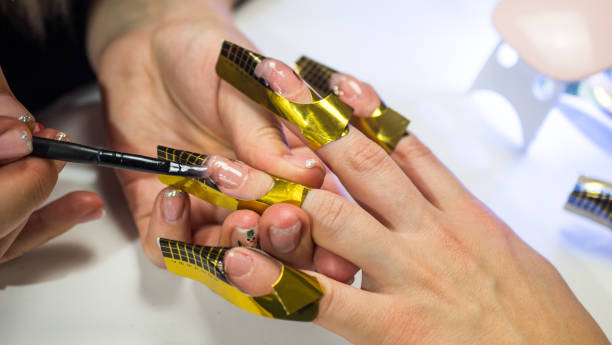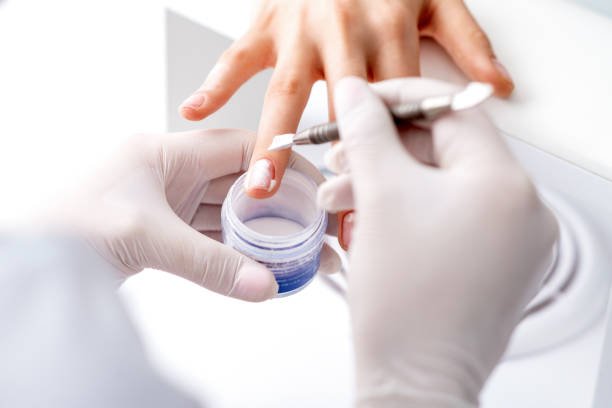There are two types of manicure systems that work the best: dip powder and gel polish. These systems are durable, simple to apply, and long-lasting.
However, the two systems differ in significant ways that make some of them better suited for some people than others.
I am here to break down the pros and cons of both dip powder and gel polish in this article. This will help you decide which is the most appropriate choice for you.
What looks better – Gel or Dip Powder
The results of Gel Polish and Dip Powder can be stunning if they are applied correctly.
My opinion is that gel polish manicures tend to look better than dip powder manicures. The reasons might include:
- The more options you have, the more creative you can be with gel polishes – since such a wide variety of colors, shades, and types are available.
- You can take your time to make and design amazing nail art with gel polish since it only cures when exposed to UV light.
- The glossy look of Gel Polish is achieved without a top coat, whereas Dip Powder needs one.
Risks of Using Gel Polish:

It is UV light that is responsible for the main health risk associated with gel polishes. UV light is used to cure and harden gel polishes.
Since your nails are too thick to permit the light to penetrate through them, your nails won’t be damaged by UV light. Your fingers and hands, however, will be subjected to UV light.
Exposure to strong UV light for a long time can potentially lead to skin cancer.
So far, there hasn’t been any research showing that skin ailments like skin cancer are caused by short exposure to UV radiation from nail lamps.
The only time you might want to avoid gel polish is if:
- Ultraviolet light is particularly harmful to you
- If you’ve had skin cancer in the past
- Or just wish to avoid excessive UV exposure
Alternatively, you can wear manicure gloves or apply sunscreen to your hands to protect your skin. The UV light is blocked by both sunscreen and manicure gloves, allowing only the gel polish to be exposed to it.
Risks of Using Dip Powder:

There are two main health risks associated with Dip Powder:
- As a result of an allergy to the base
- You can contract an infection if you re-use dipping jars and share them with others.
One of the ingredients in the Dip Powder Base is a monomer called cyanoacrylate which can cause allergic reactions.
You will see swelling and irritation around your nails if you have an allergic reaction to the dip base.
In order to keep you safe, it is imperative that if you have a dip powder manicure at a salon the powder isn’t reused. This is because the same jar is used for several customers.
As a result, bacteria, fungi, and other germs tend to remain inside the container, making it easy for them to pass the germs on to the next person who dips their fingers into the powder.
Instead of reusing the dip powder, the salon should sprinkle it over your nails and then throw away any powder that did not adhere to your nails.
By reusing the powder or allowing every client to dip their nails in the same container, your salon is putting you at risk for an infection.
In conclusion
Once used properly and precautionary steps are taken, neither Gel Polish nor Dipping Powder poses any major health risks. You should not base your manicure decision on whether they are safe or not.
Dip Powder vs Gel: Which is Worse for Your Nails?
Gel Nails and Dip Powder will not harm your nails in any way. You are more likely to damage your nails if you improperly remove or apply your manicure.
Compared to gel polish, Dip Powder Nail Polish is now more difficult to remove. Consequently, they may damage your natural nails more than usual
Due to the filing and acetone used in Dip Powder manicures, your natural nails are at more risk of damage.
There’s no need to worry about manicure damage as your nails are more likely to be harmed by things like:
- Acid-based nail primers and other strong chemicals are not recommended.
- Make sure your nails are over filed before applying nail primer.
- Damage to the nail plate is caused by improper removal of the manicure.
Dip Powder or Gel Polish: What’s easier to apply?
When it comes to applying Gel Polish, it is generally easier than applying Dip Powder.
The difference between Gel Polish and regular nail polish is that Gel Polish is cured with a UV lamp.
It means that you can take your time applying gel polish because it cures only when you are ready to use it. Additionally, gel polish can easily be removed with rubbing alcohol if you make a mistake.
In contrast to other conventional manicures, Dip Powder uses an entirely different system.
How Long Does Gel Polish Last Compared to Dip Powder?
When applied correctly, Dip Powder can last for up to 3-4 weeks, which is longer than the average duration of gel polish.
It is cyanoacrylate that holds down the dip powder. In addition, cyanoacrylate is the same chemical that’s in super glue, which is why dip powder won’t lift or peel.
What is more durable, dipping powder or gel
Gel polish is more durable than dip powder, so it’s great for those whose nails are often exposed to harsh conditions.
Apparently dip powder is able to withstand harsh conditions before exhibiting signs of wear.
Those with nails that are constantly exposed to detergents, heat and chemicals like dyes and alcohol must opt for a dip powder manicure.
Dip Powder or Gel Polish – Which is more difficult to remove?
Gel Polish can be removed more easily than Dip Powder.
Gel Polish and Dip Powder are both removed in the same way. During both types of manicures, the top layer must be scraped off and then soaked in acetone.
However, Dip Powder, since it is more durable, requires more filing, and it is best to soak directly in acetone for 15-20 minutes.
When removing gel polish, soak cotton balls in acetone and wrap them around the nails before scraping them off after 10-15 minutes.
Utilizing cotton balls only exposes the gel polish to acetone, avoiding skin contact with the solvent.
How do Gels & Dips compare in price & availability
Almost every nail salon offers gel manicures, which means you can get a gel manicure at almost any time. In addition, gel manicures tend to be more affordable than Dip Powders.
Nevertheless, Dip Powder manicures may be more cost-effective since they tend to last longer.
Dip Powder manicures typically cost between $10 and $15 more than gel manicures, though prices may vary among salons.
Comparison of Dip Powder and Gel Extensions
The following section discusses Dip Powder Extensions and Gel Extensions. There are several differences between Gel Extensions and Gel Polish, including their various properties and functions.
The differences between these two manicure systems required a separate section to compare them.
Using gel extensions, you extend the length of your natural nails by building them out with a thick, clear gel. In addition, a gel polish, or a regular polish, or a dip powder is applied.
Alternatives to acrylic nails include gel extensions, which look more like acrylic nails.
Unlike gel polish and regular polish, Dip Powder is used as a substitute for gel polish. Also, you can use them with acrylic, gel, or tip extensions.
Gel Extensions can be Hard Gel or Soft Gel. The most popular type of gel extension is Hard Gel.
Comparing hard gel extensions and dip powder manicures:
A hard gel extension is usually more durable, long-lasting, and better at lengthening your nails than a soft gel extension.
Nevertheless, they are more expensive, more difficult to apply, and more difficult to remove.
